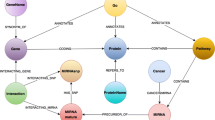Abstract
We present the Bio Scene Graph (BioSG) for visualization of biomolecular structures based on the scene graph system OpenSG. The hierarchical model of primary, secondary and tertiary structures of molecules used in the organic chemistry is mapped to a graph of nodes when loading molecular files.
We show that using BioSG, displaying molecules can be integrated in other applications, for example in medical applications. Additionally, existing algorithms and programs can be easily adapted to display the results with BioSG.
Access this chapter
Tax calculation will be finalised at checkout
Purchases are for personal use only
Preview
Unable to display preview. Download preview PDF.
Similar content being viewed by others
References
Vinay Siddavanahalli, Chandrajit Bajaj, Peter Djeu, and Anthony Thane. TexMol - interactivevisual exploration of large flexible multi-component molecular complexes. IEEE Visualization, 2004.
Forrester Consulting. The microsoft office fluent user interface: Information worker perceptionof productivity, training, and support requirements. User study, Forrester Research, Inc., 400Technology Square, Cambridge, MA, USA, August 2007.
Mario Botsch, Christian Sigg, Tim Weyrich, and Markus Gross. GPU-based ray-casting ofquadric surfaces. Eurographics Symposium on Point-Based Graphics, 2006.
Tolga Can, Yujun Wang, Yuan-Fang Wang, and Jianwen Su. FPV: fast protein visualizationusing Java 3D. In Proceedings of the 2003 ACM symposium on applied computing, 88-95.ACM press, 2003. http://www.ceng.metu.edu.tr/tcan/fpv/~tcan/fpv/.
W. L. DeLano. The PyMOL molecular graphics system. http://www.pymol.org/.
T. Exner, G. Moeckel, M. Keil, and J. Brickmann. Molecular modeling information transferwith VRML: from small molecules to large systems in bioscience. In Pacific Symposium onBiocomputing, 327-338. World Scientific, 1998.
Andreas Halm, Lars Offen, and Dieter Fellner. Visualization of complex molecular ribbonstructures at interactive rates. In IV ’04: Proceedings of the Information Visualisation, EighthInternational Conference on (IV’04), 737-744, Washington, DC, USA, 2004. IEEE Computer Society.
Andreas Halm, Lars Offen, and Dieter W. Fellner. BioBrowser: A framework for fast proteinvisualization. In EuroVis05: Joint Eurographics - IEEE VGTC Symposium on Visualization,Leeds, United Kingdom, 1-3 June 2005, 287-294. Eurographics Association, 2005.
C. W. V. Hogue. Cn3D: a new generation of three-dimensional molecular structure viewer.Trends in Biochemical Sciences, 314-316, 1997. ftp://ftp.ncbi.nih.gov/cn3d/.
Jmol: an open-source java viewer for chemical structures in 3D. http://www.jmol.org/.
M. E. Kabay. Arrogance or efficiency? A discussion of the microsoft office fluent user interface.Ubiquity, 1-4, March 2008.
M. Krone, K. Bidmon, and T. Ertl. GPU-based Visualisation of Protein Secondary Structure.In Proceedings of TPCG 2008, 115 - 122, 2008.
MFC Feature Pack for Visual C++ 2008. http://msdn.microsoft.com/en-us/library/bb982354.aspx.
Molekel. http://molekel.cscs.ch/wiki/pmwiki.php.
Lars Offen and Dieter Fellner. BioBrowser - visualization of and access to macro-molecularstructures. In Visualization in Medicine and Life Sciences, 257-273. Springer Verlag, 2007.
OGRE - Object-Oriented Graphics Rendering Engine. http://www.ogre3d.org/.
OpenSceneGraph. http://www.openscenegraph.org/.
OpenSG. http://www.opensg.org/.
E. F. Pettersen, T. D. Goddard, C. C. Huang, G. S. Courch, D. M. Greenblatt, E. C. Meng, andT. E. Ferrin. UCSF Chimera - A visualization system for exploratory research and analysis.Journal of computational chemistry, 1605-1612, 2004. http://www.cgl.ucsf.edu/chimera/.
Dirk Reiners, Gerrit Voß, and Johannes Behr. OpenSG: Basic concepts. In 1. OpenSGSymposium OpenSG, 2002.
Nvidia SceniX scene management engine. http://developer.nvidia.com/object/scenix-home.html.
J. L. Sussman, D. Lin, J. Jiang, N. O. Manning, J. Prilusky, O. Ritter, and E. E. Abola.Protein data bank (PDB): database of threedimensional structural information of biologicalmacromolecules. Acta Crysallogr., 1078-1084, 1998. http://www.pdb.org/.
H. Steen and M. Mann. The abc’s (and xyz’s) of peptide sequencing. Nature ReviewsMolecular Cell Biology, 699-711, 2004.
R. Sayle and E. J. Milner-White. RasMol: Biomolecular graphics for all. Trends inBiochemical Sciences, page 374, 1995. http://www.rasmol.org/.
G. Voß, J. Behr, D. Reiners, and M. Roth. A multi-thread safe foundation for scene graphs andits extension to clusters. In EGPGV ’02: Proceedings of the Fourth Eurographics Workshopon Parallel Graphics and Visualization, 33-37, Aire-la-Ville, Switzerland, Switzerland, 2002.Eurographics Association.
Andrew Dalke, William Humphrey, and Klaus Schulten. VMD - visual molecular dynamics.Journal of Molecular Graphics, 14:33-38, 1996. http://www.ks.uiuc.edu/Research/vmd/.
Author information
Authors and Affiliations
Corresponding author
Editor information
Editors and Affiliations
Rights and permissions
Copyright information
© 2012 Springer-Verlag Berlin Heidelberg
About this paper
Cite this paper
Halm, A., Eggeling, E., Fellner, D.W. (2012). Embedding Biomolecular Information in a Scene Graph System. In: Linsen, L., Hagen, H., Hamann, B., Hege, HC. (eds) Visualization in Medicine and Life Sciences II. Mathematics and Visualization. Springer, Berlin, Heidelberg. https://doi.org/10.1007/978-3-642-21608-4_14
Download citation
DOI: https://doi.org/10.1007/978-3-642-21608-4_14
Publisher Name: Springer, Berlin, Heidelberg
Print ISBN: 978-3-642-21607-7
Online ISBN: 978-3-642-21608-4
eBook Packages: Mathematics and StatisticsMathematics and Statistics (R0)




